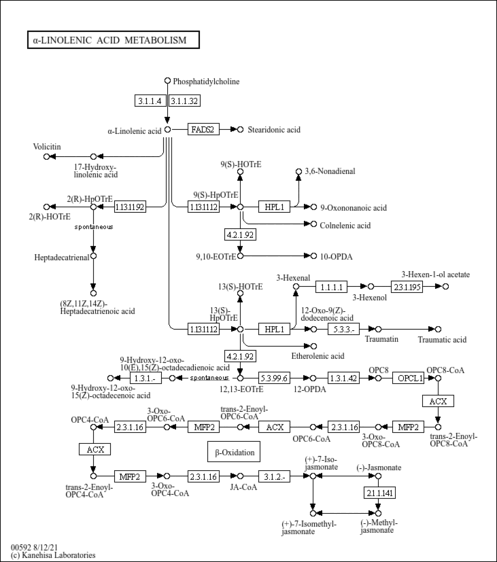| Experimental LC-MS/MS | LC-MS/MS Spectrum - Stearidonic acid LC-ESI-IT , negative-QTOF | splash10-001i-0190000000-adcd1a052c188cb4e292 | 2017-09-14 | HMDB team, MONA | View Spectrum |
| Experimental LC-MS/MS | LC-MS/MS Spectrum - Stearidonic acid Orbitrap 6V, positive-QTOF | splash10-004i-0090000000-a5d727e64a76416e19b9 | 2020-07-22 | HMDB team, MONA | View Spectrum |
| Experimental LC-MS/MS | LC-MS/MS Spectrum - Stearidonic acid Orbitrap 8V, positive-QTOF | splash10-004i-1590000000-c31b6670486c2add8842 | 2020-07-22 | HMDB team, MONA | View Spectrum |
| Experimental LC-MS/MS | LC-MS/MS Spectrum - Stearidonic acid Orbitrap 12V, positive-QTOF | splash10-05ce-5920000000-97739d72e096d14b3173 | 2020-07-22 | HMDB team, MONA | View Spectrum |
| Experimental LC-MS/MS | LC-MS/MS Spectrum - Stearidonic acid Orbitrap 14V, positive-QTOF | splash10-06gm-9800000000-e3ef89b4b4086a02043d | 2020-07-22 | HMDB team, MONA | View Spectrum |
| Experimental LC-MS/MS | LC-MS/MS Spectrum - Stearidonic acid Orbitrap 19V, positive-QTOF | splash10-05ox-9300000000-e97626343f7e356e1b0c | 2020-07-22 | HMDB team, MONA | View Spectrum |
| Experimental LC-MS/MS | LC-MS/MS Spectrum - Stearidonic acid Orbitrap 24V, positive-QTOF | splash10-05ox-9100000000-7d26fa860a4f5a50b573 | 2020-07-22 | HMDB team, MONA | View Spectrum |
| Experimental LC-MS/MS | LC-MS/MS Spectrum - Stearidonic acid Orbitrap 28V, positive-QTOF | splash10-05r3-9100000000-c0fda9d6244f70011335 | 2020-07-22 | HMDB team, MONA | View Spectrum |
| Experimental LC-MS/MS | LC-MS/MS Spectrum - Stearidonic acid Orbitrap 33V, positive-QTOF | splash10-05r3-9000000000-05ef38b3be958b95c066 | 2020-07-22 | HMDB team, MONA | View Spectrum |
| Experimental LC-MS/MS | LC-MS/MS Spectrum - Stearidonic acid Orbitrap 39V, positive-QTOF | splash10-05r3-9000000000-0e7f4cff743f21c96f9d | 2020-07-22 | HMDB team, MONA | View Spectrum |
| Experimental LC-MS/MS | LC-MS/MS Spectrum - Stearidonic acid Orbitrap 45V, positive-QTOF | splash10-0v03-9000000000-1e7762f073fff0bbf25f | 2020-07-22 | HMDB team, MONA | View Spectrum |
| Experimental LC-MS/MS | LC-MS/MS Spectrum - Stearidonic acid Orbitrap 54V, positive-QTOF | splash10-0udi-9000000000-e29ae2d32138f06d4b67 | 2020-07-22 | HMDB team, MONA | View Spectrum |
| Experimental LC-MS/MS | LC-MS/MS Spectrum - Stearidonic acid n/a 19V, positive-QTOF | splash10-08fs-0940000000-3ce59c1bcc6c938f80dd | 2020-07-22 | HMDB team, MONA | View Spectrum |
| Experimental LC-MS/MS | LC-MS/MS Spectrum - Stearidonic acid n/a 19V, positive-QTOF | splash10-05gl-6900000000-e7b111913bb0b52b7732 | 2020-07-22 | HMDB team, MONA | View Spectrum |
| Experimental LC-MS/MS | LC-MS/MS Spectrum - Stearidonic acid n/a 19V, positive-QTOF | splash10-004i-9000000000-829ac26a60349ce7dc65 | 2020-07-22 | HMDB team, MONA | View Spectrum |
| Experimental LC-MS/MS | LC-MS/MS Spectrum - Stearidonic acid n/a 19V, positive-QTOF | splash10-00di-3900000000-d5e9c06ac391b2ed266c | 2020-07-22 | HMDB team, MONA | View Spectrum |
| Experimental LC-MS/MS | LC-MS/MS Spectrum - Stearidonic acid n/a 19V, positive-QTOF | splash10-0006-9000000000-4afb061d75b952ae6397 | 2020-07-22 | HMDB team, MONA | View Spectrum |
| Experimental LC-MS/MS | LC-MS/MS Spectrum - Stearidonic acid n/a 19V, positive-QTOF | splash10-0006-0890000000-2c1d0ecbce6768af6a66 | 2020-07-22 | HMDB team, MONA | View Spectrum |
| Experimental LC-MS/MS | LC-MS/MS Spectrum - Stearidonic acid n/a 19V, positive-QTOF | splash10-0072-0900000000-d1bd13cfc0f04540d631 | 2020-07-22 | HMDB team, MONA | View Spectrum |
| Predicted LC-MS/MS | Predicted LC-MS/MS Spectrum - Stearidonic acid 10V, Positive-QTOF | splash10-056r-0190000000-db9d40fa02eaf6622425 | 2016-08-03 | Wishart Lab | View Spectrum |
| Predicted LC-MS/MS | Predicted LC-MS/MS Spectrum - Stearidonic acid 20V, Positive-QTOF | splash10-05q9-4890000000-dacdea1487478325e7aa | 2016-08-03 | Wishart Lab | View Spectrum |
| Predicted LC-MS/MS | Predicted LC-MS/MS Spectrum - Stearidonic acid 40V, Positive-QTOF | splash10-069c-8930000000-57d8480196e2c8c76857 | 2016-08-03 | Wishart Lab | View Spectrum |
| Predicted LC-MS/MS | Predicted LC-MS/MS Spectrum - Stearidonic acid 10V, Negative-QTOF | splash10-004i-0090000000-098cf1c00cd595f3355a | 2016-08-03 | Wishart Lab | View Spectrum |
| Predicted LC-MS/MS | Predicted LC-MS/MS Spectrum - Stearidonic acid 20V, Negative-QTOF | splash10-0059-1090000000-74f3f2bf4ec73b4c1454 | 2016-08-03 | Wishart Lab | View Spectrum |
| Predicted LC-MS/MS | Predicted LC-MS/MS Spectrum - Stearidonic acid 40V, Negative-QTOF | splash10-0a4i-9230000000-0bbf081c20a1f61dd3a1 | 2016-08-03 | Wishart Lab | View Spectrum |
